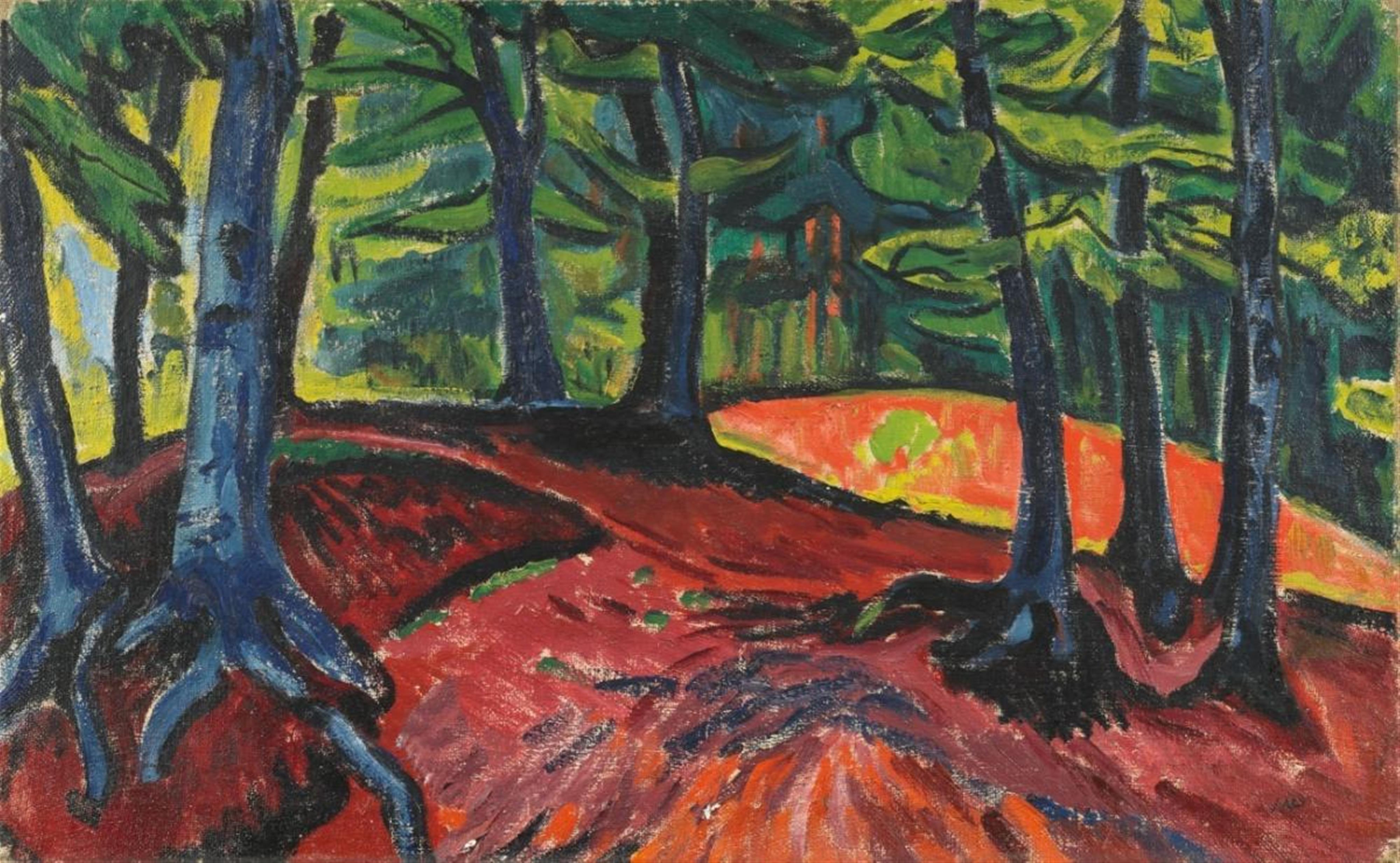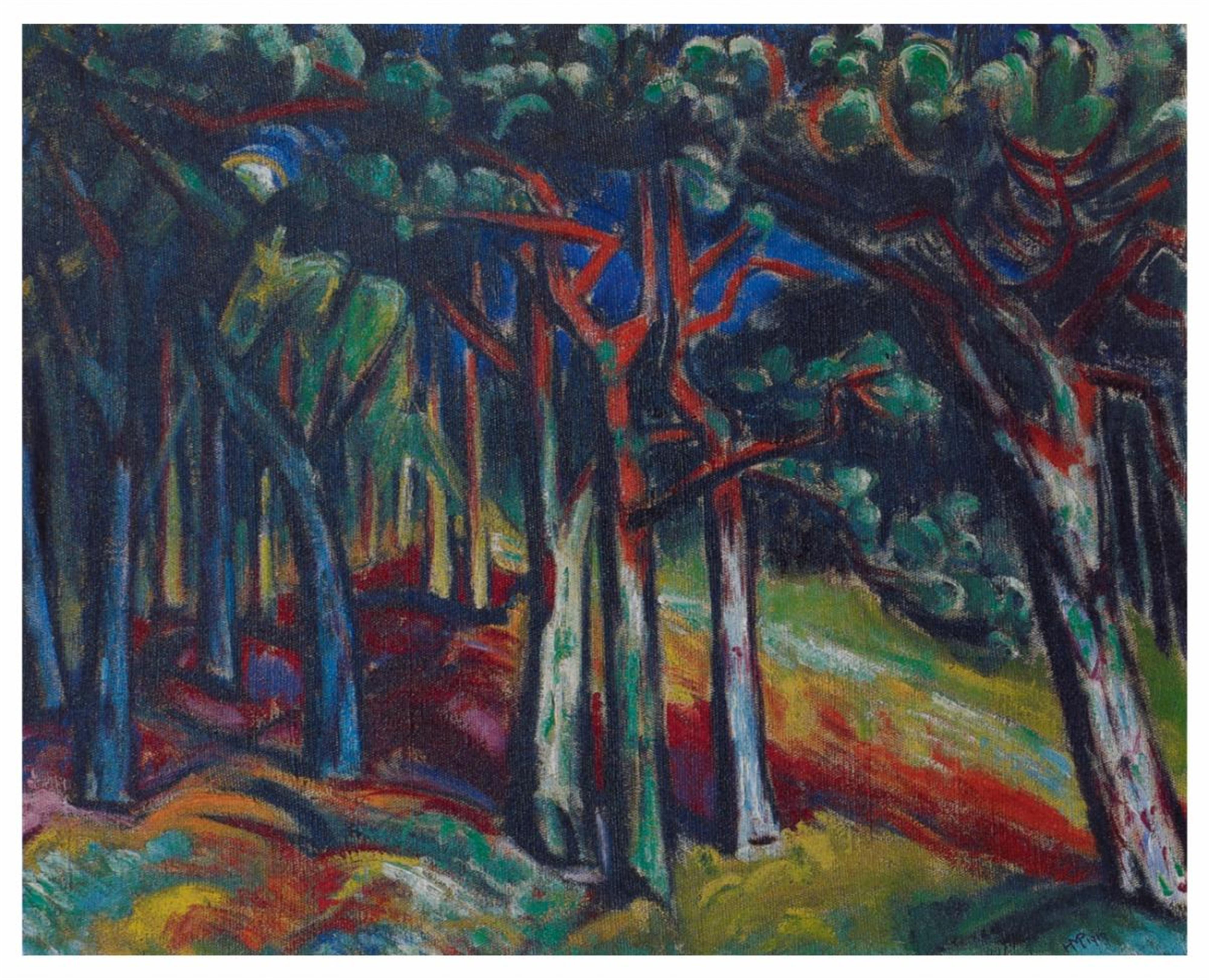Oil on rough canvas 62.5 x 100.5 cm, framed. Monogrammed 'HMP' [joined] in black lower right. - The top and side edges with tension cracks; the layer of paint cracked along upper edge with loose colour pigments and minor losses of colour.
Not recorded by Soika
Although the painting is undated, Aya Soika points out in her expertise that there are numerous stylistic and thematic elements to suggest that, from a historical perspective, it was created by Pechstein in 1919. During his four months in Nidden (today's Nida in Lithuania) from the end of June to the end of October 1919 the artist created an entire range of oil paintings, showing the same characteristic and somewhat hilly pine forest in this area. Again and again, from the summer of 1909 onwards, Pechstein would visit the remote fishing village of Nidden on the Curonian Spit in East Prussia and then spend some time painting there. In 1919 he stayed in Nidden from late June until late October. Because of the war, however, he had not been there since 1912. Thirty years later he wrote, with hindsight: “From then onwards Nidden with its shifting dunes, lagoon and narrow strip of woodland facing the Baltic became my painter's paradise.” (Lebenslauf Pechsteins, 6 April 1949, Landesarchiv Berlin B Rep.080, No. 78, in: Aya Soika, Max Pechstein, Das Werkverzeichnis der Ölgemälde, vol.1, Munich 2011, p. 31). In the summer of 1919, Pechstein had a highly productive phase, creating a large number of paintings featuring dunes, the coast and the woods. In October that year he wrote to his old friend, the author and art critic Paul Fechter: “Everything in my art is drowning in colour, my brain is only filled with pictures, and the ideas for a painting keep chasing me from one place to another…” (Letter to Paul Fechter, Nida, 2 Oct. 1919 , Getty Archives, Los Angeles, in: Soika, op. cit., p.38).
The radiance of his colours, which he used quite consciously, is the result of a powerful contrast between red and green. The vehement effect of these complimentary colours is enhanced even further by the black lines and contours which add structure to the painting. Shades of blue and green add a note of mystery to the woods, whereas the vivid red - fired up by a dune that shines forth in yellowish orange - may betray a certain tension and agitation within the artist. At the same time, the different colours of this clearing suggest a certain depth within the composition. The purple that is used here for the soil in the woods can also be found frequently in his works in 1919. Pechstein's style permitted him to translate his experiences directly into art, creating a certain suspense. On the one hand, he was concerned about the state in which he might find his beloved Nidden after a long period of war and after his absence. On the other hand, he always succeeded very quickly in deriving inspiration from the charm of nature and from the colour harmonies of each season.
By 1919 Pechstein was already an accomplished artist: a solo exhibition at the prestigious Galerie Arnold, where he displayed 46 paintings and 40 watercolours, and also an exhibition given by his art dealer, Wolfgang Gurlitt in Berlin, where 24 paintings from Nidden were shown to the public, are proof of his success. According to Aya Soika, there is documentary evidence of 25 forest paintings for 1919. This piece, therefore, which has now become known is therefore a delightful enrichment as it may close a further gap in the research on Pechstein.
Certificate
With a certificate from Aya Soika, Berlin, dated 17 October 2012
Provenance
Galerie Commeter, Hamburg (acquired 1949); private collection, Kiel, since then in family possession
Exhibitions
Kiel 1955 (Kunsthalle Kiel), Kunstwerke aus Kieler Privatbesitz, Gemälde, Zeichnungen, Graphik, Plastik, cat. no. 66 ("Waldinneres")




